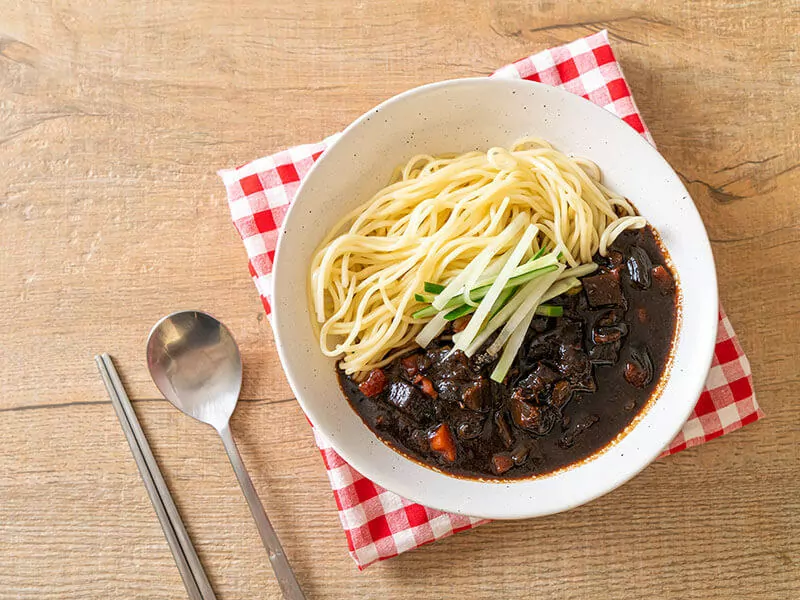
I have been a fan of these types of Korean noodles for years. If you also love Korean food but haven’t tried them, after reading this post, I bet you would want to head to the closest Korean restaurant and try some of these noodles.
Indeed, I will show you all information about the most delicious varieties of Korean noodles, including the ingredients, flavors, ways of serving, and other fun facts about these noodle varieties.
They all have their own distinctive features that you will be fascinated by. Keep reading to learn more!
23 Amazingly Delicious Types Of Korean Noodles
Korean noodles are classified into several categories. Some are warm, some are cold, and some are served as side dishes. Let’s learn everything about them in the subsections below.
An Overview Of 3 Main Korean Noodle Varieties
Before talking about specific noodle dishes, I want to provide more information about the different types of Korean noodles that people use in these recipes. Let’s check them out!
1. Dangmyeon
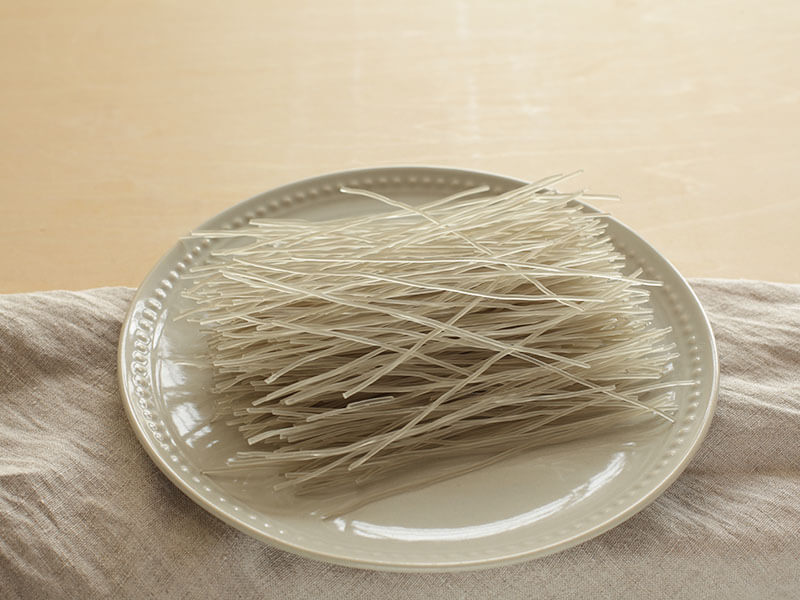
Dangmyeon is also called “cellophane noodles”, “dangmyun”, and “tang myun”. It consists of sweet potato starch. You can purchase it in the dried form, soak it, and add it to stir-fried dishes and various Korean soups.
This type of noodle has a brownish-gray color, thick shape, and is crunchy when uncooked. However, it becomes chewy and semi-transparent after cooking.
Korean people use it to make Japchae, a very famous noodle dish consisting of beef, vegetables, sesame oil, soy sauce, and sugar.
2. Cheonsachae
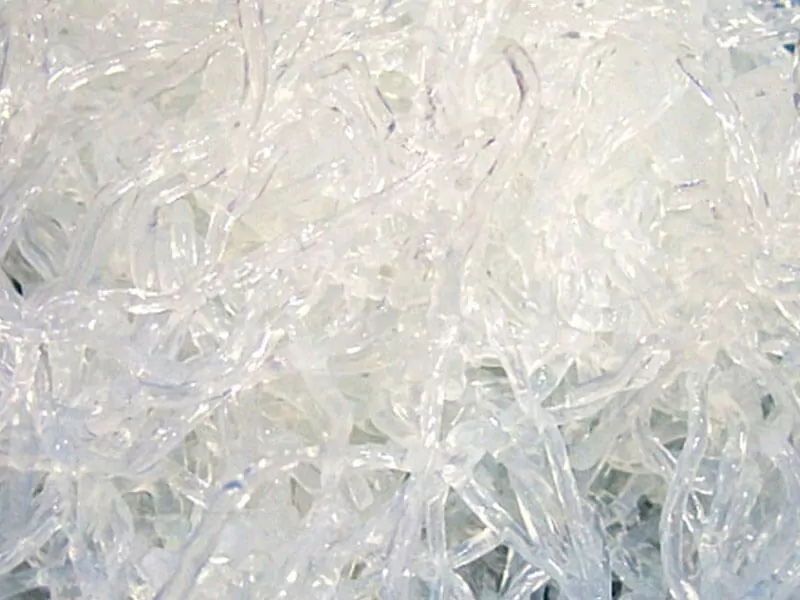
Cheonsachae has a transparent look and chewy texture.
People make this crunchy noodle with the jelly-like extract of steamed kelp. No grain flour or starch is present.
It is particularly low in calories and carbohydrates and does not contain any gluten, cholesterol, or fat. Therefore, it is very popular among people concerned about their health.
People often use it to replace rice and pasta. They make soups and stir-fried dishes. You can use it to make salads or serve it with Saengseon Hoe (sliced raw fish). It can absorb the flavor of other ingredients.
You can eat Cheonsachae raw or cook it in water with spices. If you stir fry it, add it to the dish when you nearly finish cooking it. Make sure that you rinse it beforehand.
This Cheonsachae salad recipe is a healthy, refreshing, and tasty choice.
3. Dotori Guksu
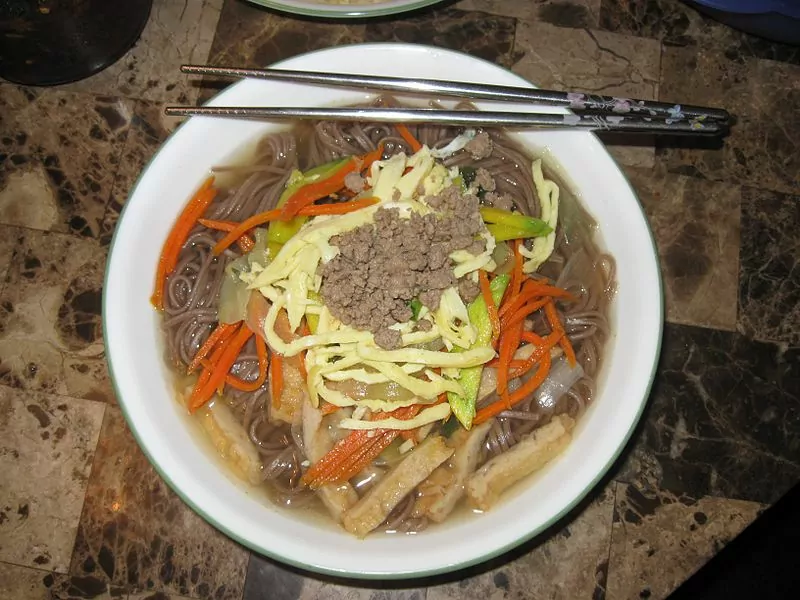
The tasty flavor and texture of Dotori Guksu will amaze you.
Dotori guksu comprise acorn starch or flour, grain-based flour, and salt. The acorn comes from red or white oak.
There are 2 varieties of Dotori Guksu, which are flour-based and starch-based. The flour-based version is also called “acorn soba noodles”. It has a thick shape, just like spaghetti. People use it to make warm and cold dishes.
The starch-based variety normally contains acorn starch, rice, potatoes, wheat flour, and arrowroot starch. They have a chewy and elastic texture when cooked. Uncooked Dotori Guksu’s thickness is about 1-1.2 mm in diameter. It looks just like brown plastic threads.
7 Warm Korean Noodle Dishes To Stay Cozy
If you are seeking a warm and hearty dish to enjoy on cold winter nights, check out these warm Korean noodles. Give them a try, and they will become your favorite dishes.
1. Janchi Guksu (Banquet Noodles)
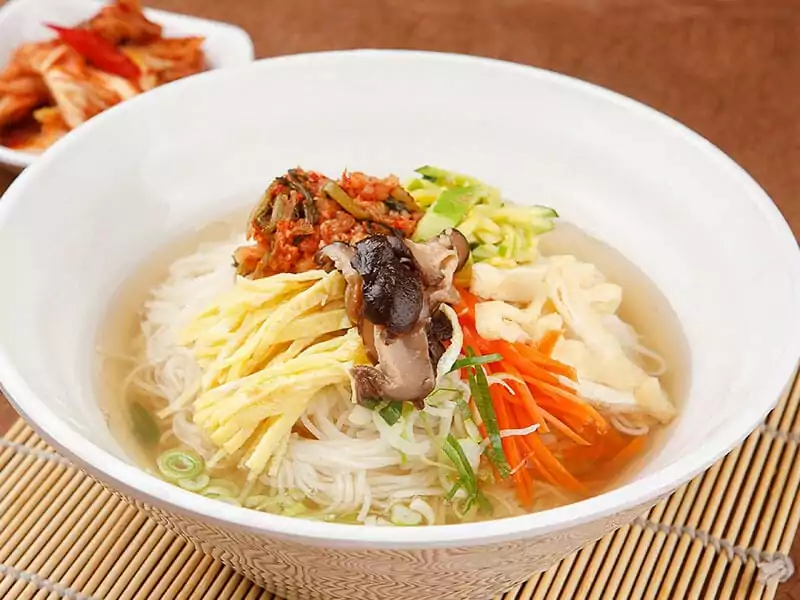
Korean people enjoy Janchi Guksu at special events such as weddings and birthdays. This noodle dish has an essential role in the cuisine of Korea. It represents longevity.
Janchi means “banquet,” and Guksu means “noodles” in its name. It features Somyeon noodles in a beef and kelp broth. The broth is light and very clear.
The toppings for Janchi Guksu are often Yangnyeomjang, sliced zucchini, and fried eggs. It goes best with a mouth-watering salad for autumn.
Yangnyeomjang is a delicious dipping sauce consisting of sesame oil, chili pepper powder, Ganjang, and scallions.
2. Jjamppong (Spicy Mixed-Up Noodle Soup)
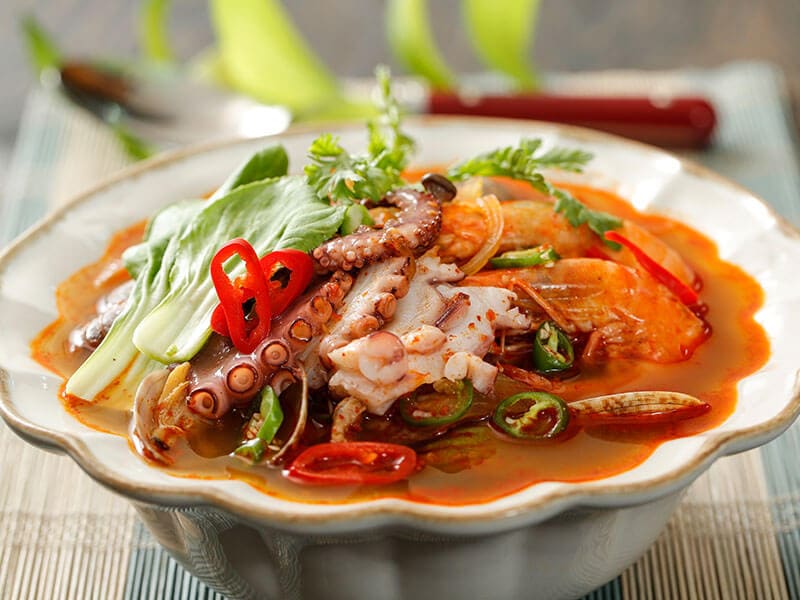
This noodle has an exciting history. Although it stems from Chǎomǎmiàn, a Chinese dish in Shandong style, its name is derived from a Japanese noodle called Chanpon. Korean people adapted the recipe and changed it to “Jjamppong”.
Jjamppong is a spicy noodle consisting of seafood or pork. It has an attractive red color thanks to Gochugaru, a type of Korean chili powder. In addition, it also has vegetables, such as garlic, Korean zucchini, and cabbages.
Jjamppong also has the stir-fried version. People call it pork back-bone Jjampong. Gochu Jjampong is a spicier version that uses Cheongyang chili pepper. If you want more seafood, you can try Samsun Jjampong. It is more expensive than other varieties.
3. Jjajangmyeon (Black Bean Noodles)
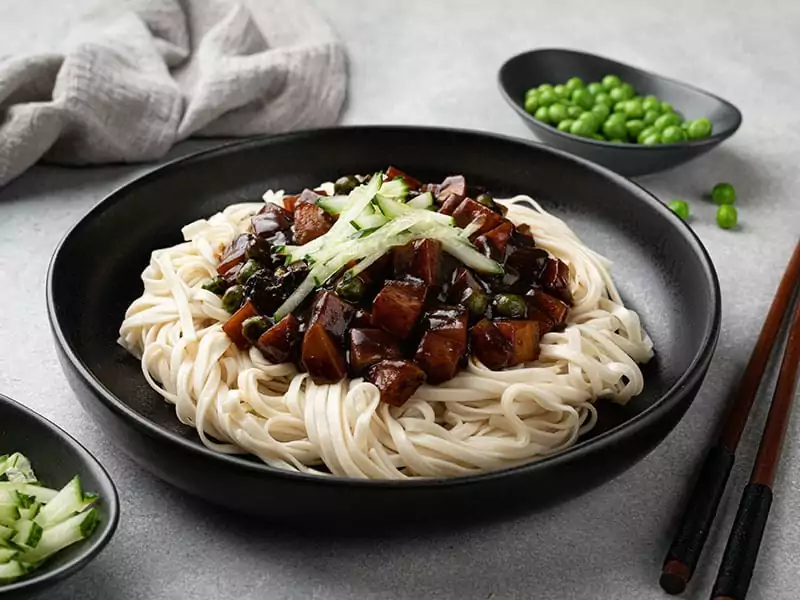
Perhaps Jjajangmyeon is one of the most famous and common Korean dishes. People love it so much that they made the instant noodle version.
Jjajangmyeon is derived from Zhájiàngmiàn, a variety of Chinese noodle originally coming from the North of China.
The noodles for it are wheat-based, similar to Japanese udon noodles. This noodle has a classic black color from black bean paste, oyster sauce, and soy sauce.
The typical toppings for Jjajangmyeon are chopped pork, boiled eggs, and Danmuji (pickled radish).
Do you believe you can make Jjajangmyeon in only 7 minutes?
4. Sujebi (Hand-Torn Noodle Soup)
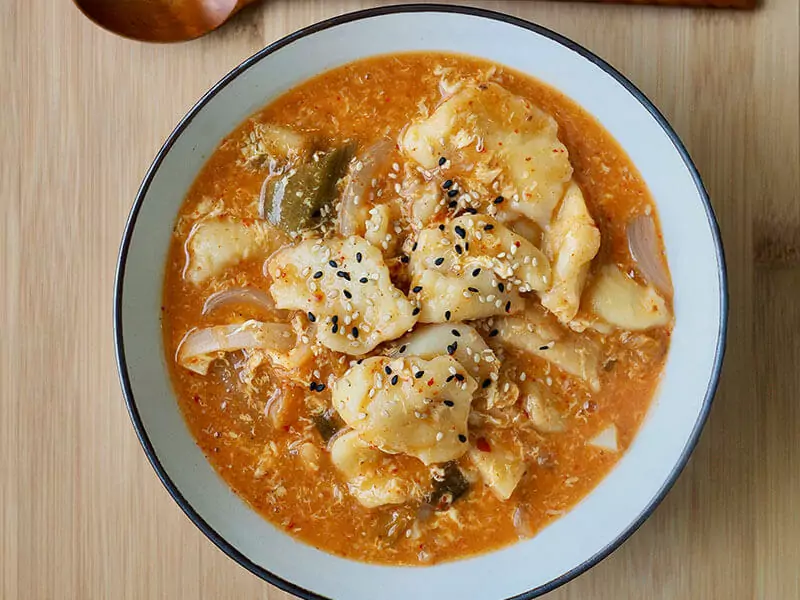
Sujebi is a special noodle dish because people don’t use commercial machine-made noodles. Instead, it uses hand-made noodles.
On the other hand, people do not cut the noodles into strands. You have to tear the noodles yourself. That’s why they do not have uniform shapes.
Apparently, the name “Sujebi” means “hand-folded” in English, which indicates the process of pulling the dough by hand.
This noodle dish has a delicious broth containing shellfish, kelp, and anchovies. Thanks to the long cooking time, it has a rich and savory flavor. They serve the noodles with vegetables such as potatoes and zucchini.
Years ago, Korean people only served Sujebi at important events like a baby’s first birthday. But at present, it has become a common dish.
5. Kalguksu (Korean Knife-Cut Noodle)
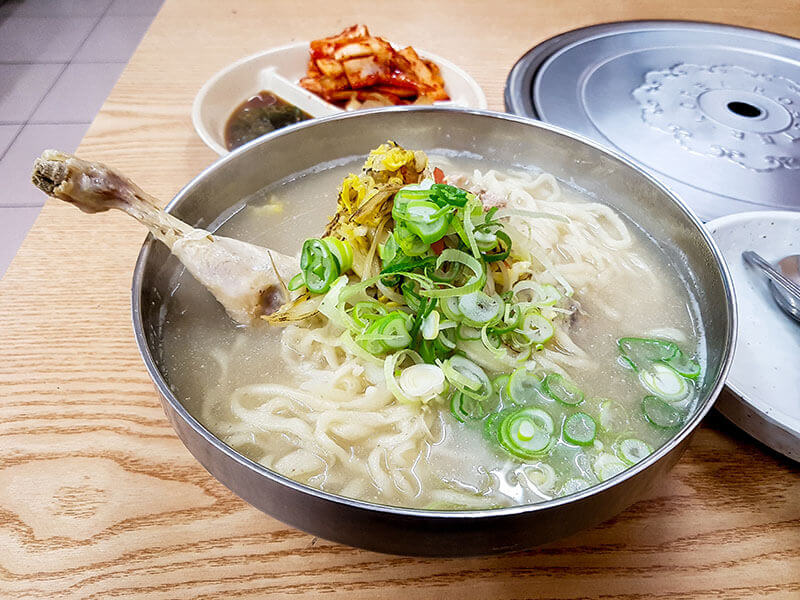
The noodles for Kalguksu consist of wheat-based noodles. People make them by rolling that dough and cutting it into strands rather than extruding or spinning it. Its name reflects the preparation method. Kal means “knife”, and Guksu means “noodle”.
The broth of Kalguksu contains anchovy, shellfish, kelp, and chicken broth. It also has meat, seafood, and vegetables such as potatoes, Korean zucchini, and scallions. Salt is the most common seasoning.
Kalguksu is particularly a popular dish that is served in winter dinners. In addition, people also love to enjoy it on summer days if they are windy and rainy.
In the past, Kalguksu was a luxurious dish because wheat flour was very expensive. People had to import it from China. But nowadays, it is much more available and affordable.
6. Bulgogi Jeongol (Bulgogi Hot Pot With Glass Noodles)
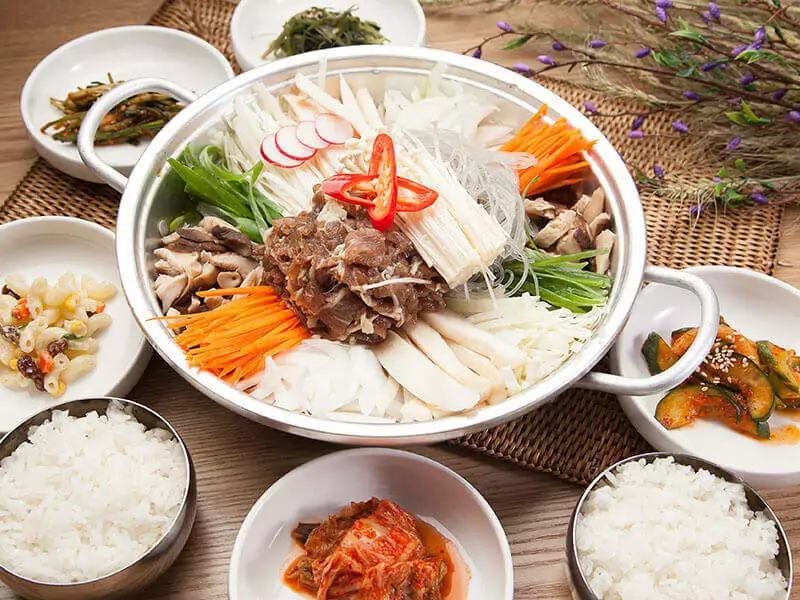
Bulgogi, in general, means “fire meat” that can be made with beef, chicken, or pork. However, the most common meat that you can find in Korean Bulgogi is beef.
Bulgogi Jeongol is a beef hot pot. It is often served with glass noodles. The broth consists of marinated beef, carrots, mushroom, and onions.
Traditionally, people serve it in a bowl similar to other types of noodles or enjoy them boiled in a stone pot.
7. Budae Jjigae (Army Stew)
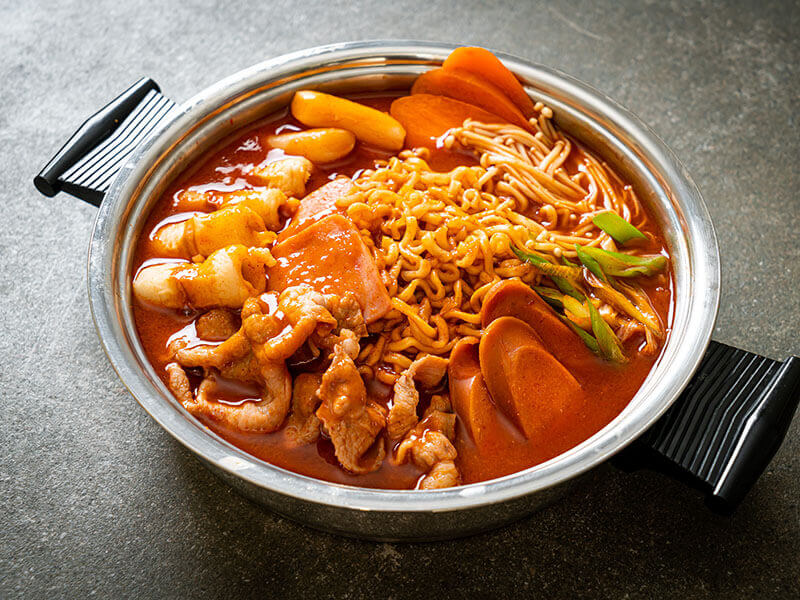
Budae Jjigae is both a stew and a noodle soup. People often call it “army stew” because it originated in the post-war period.
The dish uses instant noodles. Other ingredients include ham – a favorite food in America, kimchi, and cheese. The broth often contains Gochujang, chicken stock, soy sauce, and fish sauce.
People often top it with a slice of American cheese. It is best to serve it alongside a delicate winter salad.
Budae Jjigae is available everywhere in Korea. However, it is particularly popular in Uijeongbu, where many army bases are located.
Making Budae Jjigae is easier than you think. Try this recipe today!
8 Super Delicate Cold Korean Noodle Dishes
What do you want for summer? A bowl of cold Korean noodles would be perfect. This section will present to you the 8 best dishes so you can have plenty of choices. Check and pick your favorite!
8. Naengmyeon (Cold Noodle Soup)
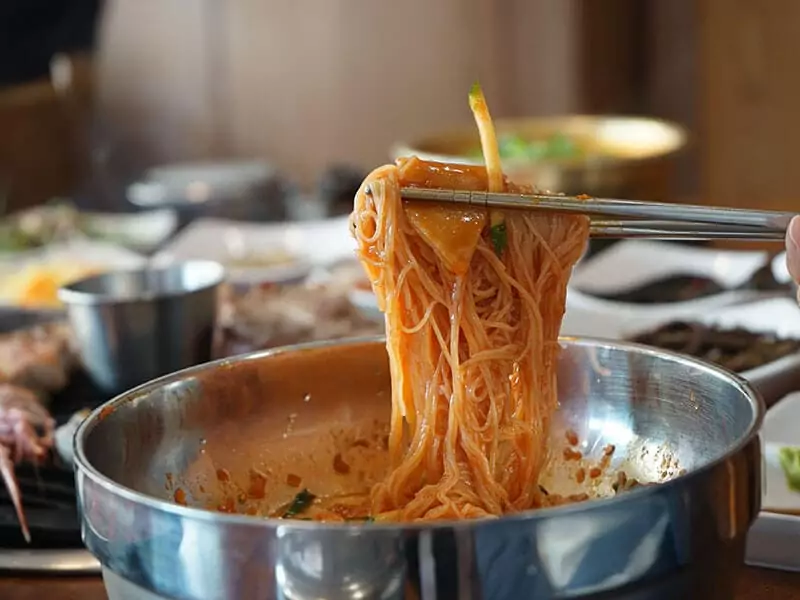
Naengmyeon came from Pyongyang, making it a delicacy of North Korea. Although it is a cold dish, people used to serve it for winter meals.
This is because the main ingredient is Dongchimi (radish-based water kimchi). It is often available in winter, so this noodle soup is more prevalent in winter.
Other elements include vinegar, sugar, and mustard oil. However, adding sugar to this recipe is more popular in North Korea.
The broth of Naengmyeon is often cold or just lukewarm. It is made of chicken and pork broth. In South Korea, people even partly freeze it or put some ice cubes in it. It is served with buckwheat noodles.
Naengmyeon has a no-broth version, which is Bibim Naengmyeon. It is a stir-fried dish with gochujang sauce as the main ingredient.
9. Jjolmyeon (Spicy Chewy Noodles)
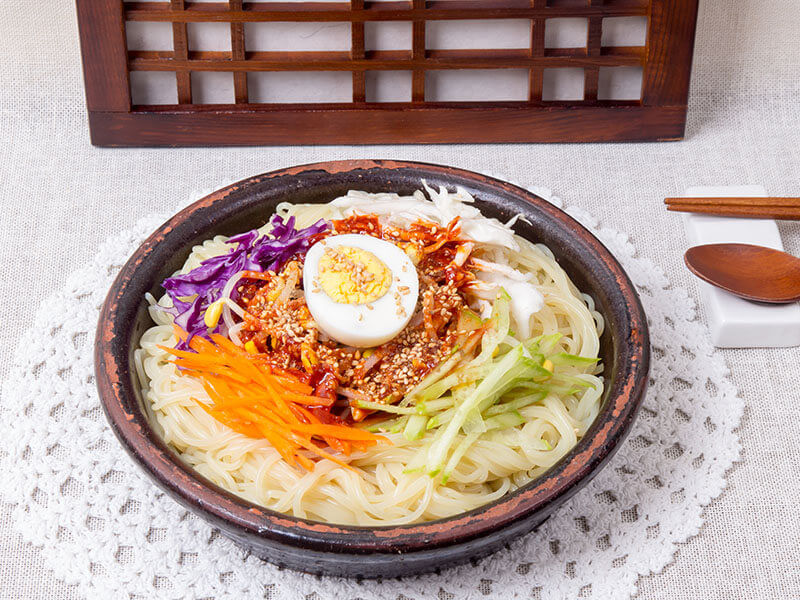
Jjolmyeon is the name of a type of noodle as well as a noodle dish. The noodles for it are very chewy. Its main ingredient is wheat flour and starch.
What is special about Jjolmyeon is that it does not contain meat at all. Most versions are vegan or may have a boiled egg. The sauce of this noodle contains vinegar, gochujang, minced garlic, and sugar.
Jjolmyeon is the favorite noodle dish of young Korean people. Interestingly, this noodle originates from a mistake when people make Naengmyeon.
This recipe will help you make the best Jjolmyeon.
10. Jat Guksu (Pine Nut Noodles)
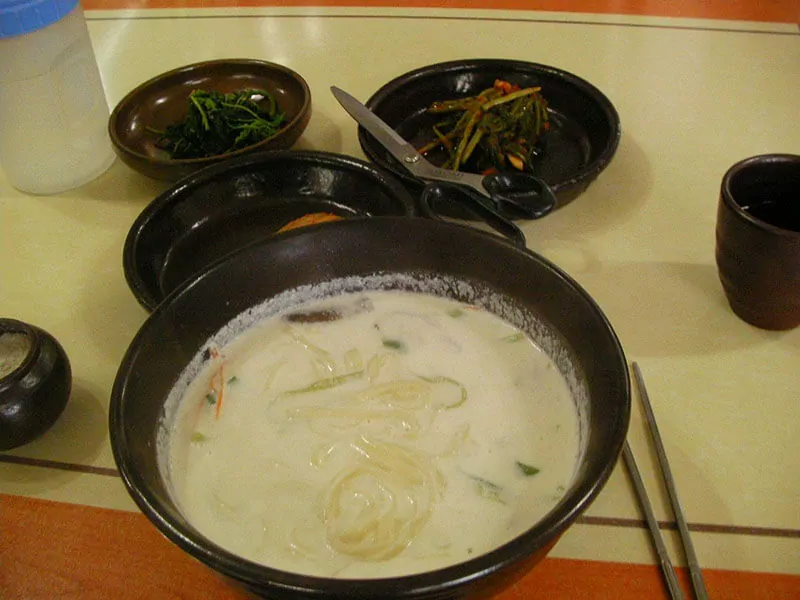
Jatguksu has a delicious nutty and umami taste.
Jat Guksu is a sweet rather than a savory noodle. Its broth is made of ground pine nuts, which offer a buttery flavor and creamy texture thanks to their high fat content. People serve it cold with wheat flour or buckwheat noodles.
You can find this delicious and refreshing noodle in Gapyeong, located in the Gyeonggi province. Don’t confuse it with Kongguksu! It does not contain soy milk at all. In addition, Kongguksu broth is more umami than Jat Guksu.
11. Makguksu (Buckwheat Noodle Salad)
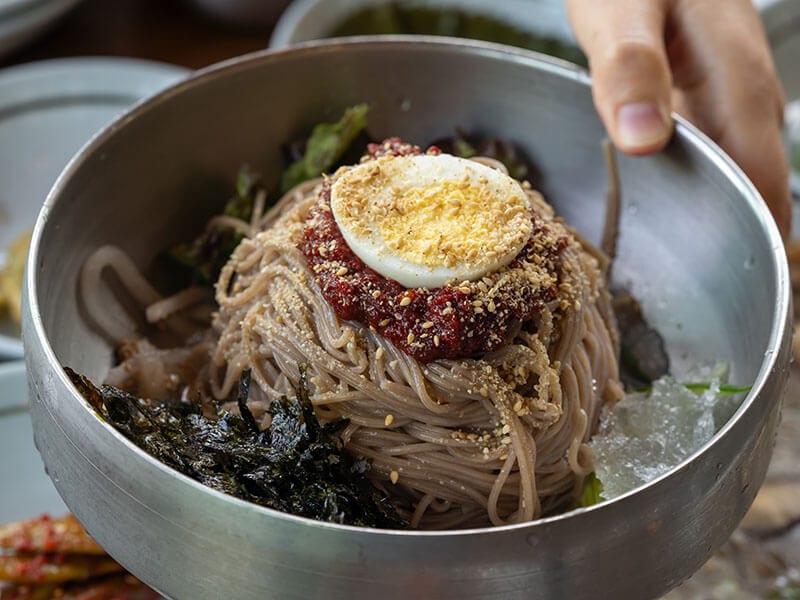
Maksguksu is a delicacy of the Gangwon province. It features buckwheat noodles in a cold broth consisting of sesame oil or vinegar, mustard, and sugar. It also has a lot of vegetables. In Chuncheon, people serve it with boiled pork or beef.
The buckwheat noodle used to make Makguksu is quite rough since it is unhulled. Furthermore, it contains a lot of buckwheat, and buckwheat is not as glutinous as other types of grain, so it is hard to knead and shape it into strands.
Makguksu has a spicy taste thanks to Gochujang and kimchi. It can also be salty because of soy sauce.
12. Milmyeon (Busan Cold Noodles)
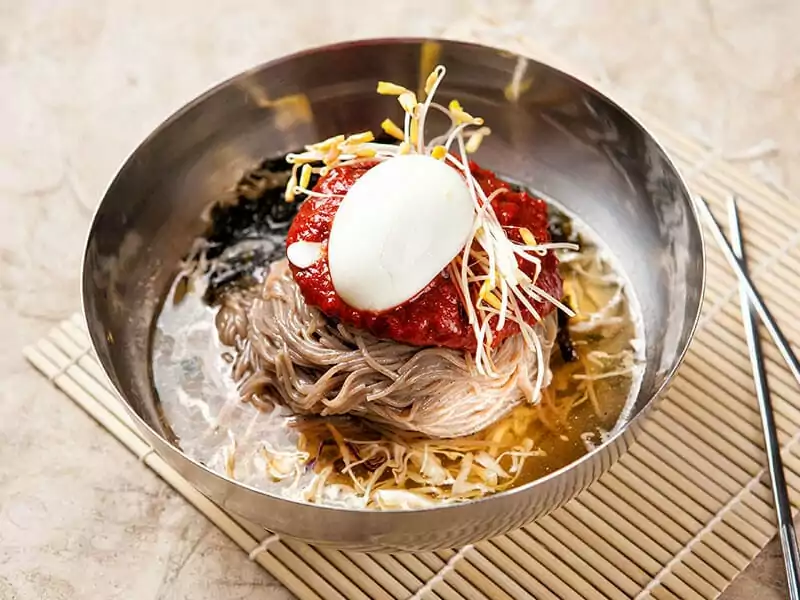
This noodle has a meaningful history. It was North Korean people who created this dish. When they came to Busan because of the Korean war, they tried to make a noodle similar to Naengmyeon. That’s where Milmyeon came into existence.
Because of that, Milmyeon is nearly the same as Naengmyeon. The biggest difference between them is the noodles. Milmyeon uses wheat flour noodles instead of buckwheat noodles since buckwheat was not available at Busan.
Common Milmyeon toppings are boiled eggs, green onions, and thinly sliced cucumbers. Serve it with a refreshing cool appetizer to beat the heat of summer.
Another difference is that Milmyeon uses meat broth to replace Dongchimi (radish water kimchi).
There are 2 varieties of Milmyeon, namely Mul Milmyeon and Bibim Milmyeon. The only difference between them is that Bibim Milmyeon has a spicy sauce.
13. Kongguksu (Soy Milk Noodle Soup)
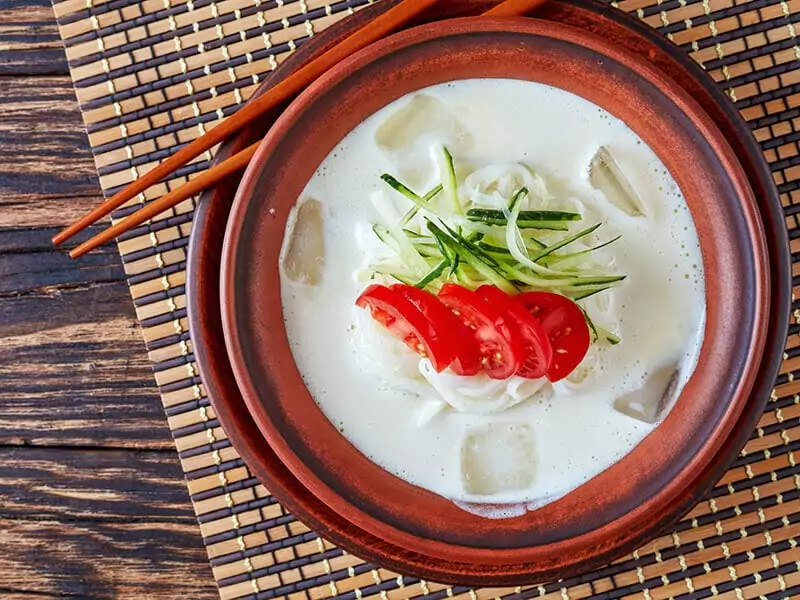
Kongguksu is a true summer retreat. It consists of Somyeon, a type of Korean noodles, and soy broth. People make it by soaking, boiling, peeling, and turning the soybeans into a puree. They may also add nuts or sesame seeds.
Notably, people add some fruits, such as chilled tomatoes, cucumber, or watermelon, to make the noodle more refreshing. Sometimes, they even put ice cubes in it.
14. Bibim Guksu (Spicy Mixed Cold Noodles)
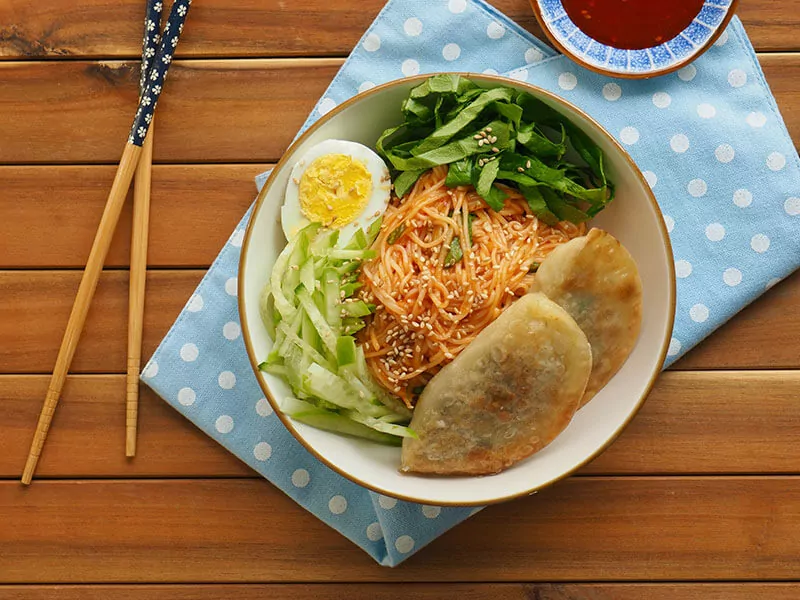
I am sure that Bibimbap is very familiar to you. It is a very famous rice dish. Bibim Guksu is nearly the same as Bibimbap. However, people make it with noodles instead of rice.
It features noodles stirred with gochujang sauce and vinegar. Such a tasty noodle is perfect for serving as a dinner dish on summer days.
Its topping is also the same as Bibimbap, which includes hard-boiled eggs, seaweed, vegetables, and pickled radishes.
Most often, people make Bibim Guksu using Somyeon noodles. If soba noodles are used, people call it “Jaengban Guksu”.
In Incheon, people use thick and chewy wheat noodles that look pretty much like spaghetti. This version is called Jjolmyeon.
15. Memil Guksu (Cold Soup Noodles)
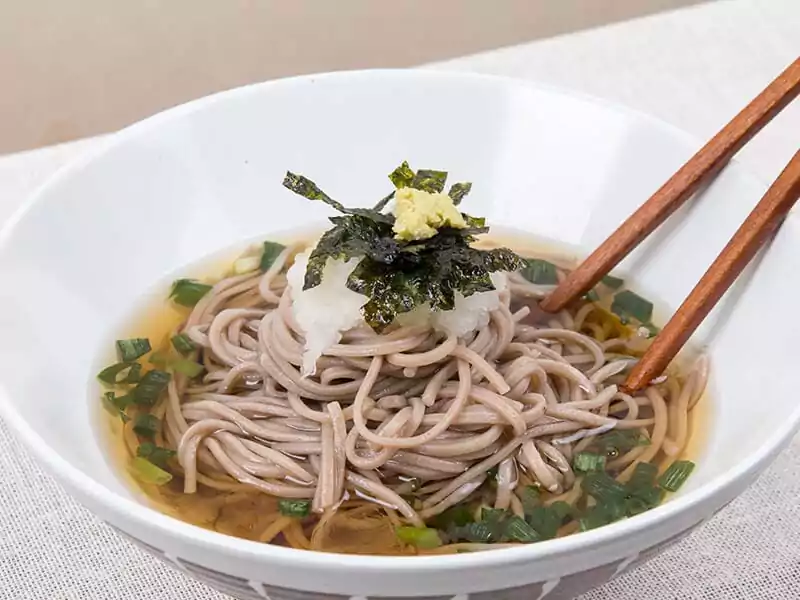
Memil Guksu features buckwheat noodles served in a clear broth consisting of soy sauce, Myeolchi, rice wine, kelp, and sugar.
This noodle is very similar to soba, a variety of Japanese noodles. However, in soba, the broth and noodles come separately. Yet, in Memil Guksu, people serve them in the same bowl.
Memil Guksu usually goes with a dipping sauce consisting of rice wine and soy sauce. The toppings for Memil Guksu include ground radish, horseradish paste, and shredded cucumbers. People sometimes add some lemon juice to make it richer.
2 Tasty Korean Noodles That Are Served As Side Dishes
Korean dishes are famous for their Banchan, which means side dishes. Noodles are also one of them. In this section, I will share with you 2 classic dishes that Korean people love to eat. Read on!
16. Cheonsachae (Kelp Noodle Salad)
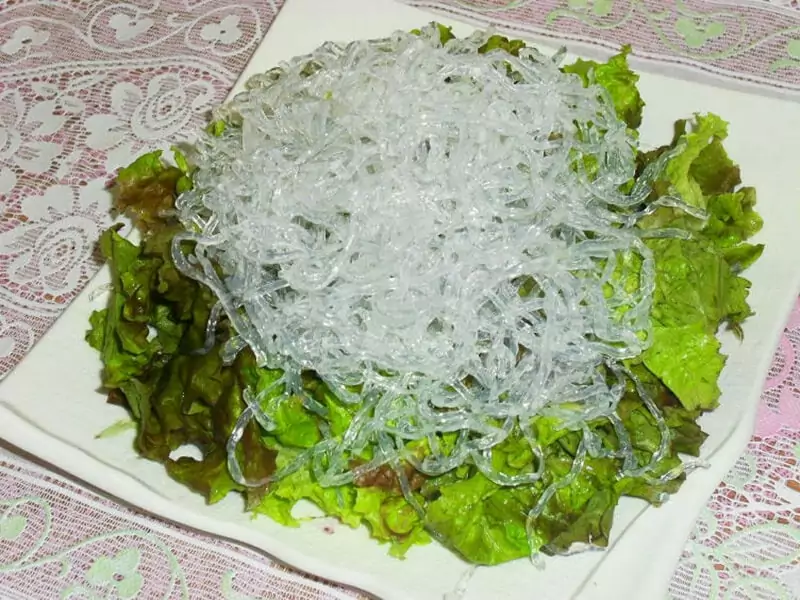
Cheonsachae has a rich and tangy sauce.
Cheonsachae is a salad. It is a very famous summer side for any meal. The noodles that people use to make it are very special. They don’t consist of starch or grain flour. People make them from the extract of a type of seaweed called “kelp”, which has a jelly-like texture.
These noodles have a deliciously crunchy texture and a semi-transparent look. People eat them raw or cook them in water and flavor them with spices. What they love about this noodle is that it is low in calories.
Some people also stir fry kelp noodles. They rinse the strands and add them at the end of the cooking procedure. In addition to the noodles, Cheonsachae also has shredded vegetables and a dressing consisting of vinegar and mayo.
17. Japchae (Noodle Stir Fry)
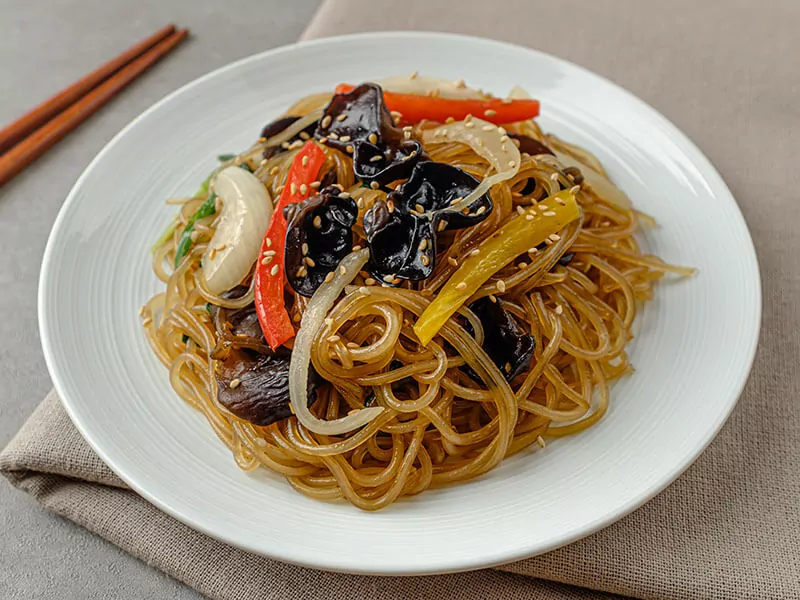
Japchae is a very popular side dish in Korea. It features stir-fried noodles with meat, vegetables, and mushrooms. The meat can be beef, pork, or chicken. You can serve it warm or cold. The noodles used are Dangmyeon noodles (cellophane noodles).
A Japchae dish always consists of 5 colors: green, yellow, white, black, and red. They come from carrots, spinach, mushrooms, and fried eggs. This feature gives rise to its name, which means “a blend of vegetables”. The sauce often has soy sauce and sesame sauce.
This noodle has an important status in Korean culture. It is a great salad for winter. People often serve it at special events such as birthdays, holidays, and weddings. It is often a side dish but can also be a main dish.
This Japchae recipe will surely be a crowd-pleaser.
4 Types Of Korean Instant Noodles For Quick And Delicious Meals
Korean instant noodles are your savior if you get home late with an empty stomach. They have been the favorite food of Korean people for years. Let me introduce you to some famous flavors.
| Type of Korean instant noodles | Characteristics |
| Samyang Ramyeon | Chicken and beef flavor, very spicy |
| Chapaguri | Spicy and umami |
| Shin Ramyun | Beef flavor, rich and deep, use chewy noodles |
| Buldak Bokkeummyeon | Chicken flavor, very spicy, use chewy noodles |
18. Samyang Ramyeon
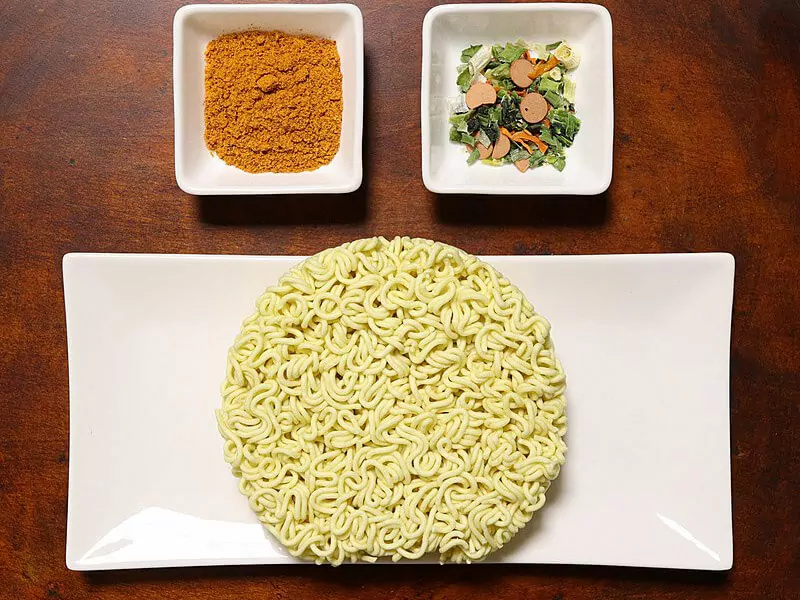
Samyang Ramyeon used to be the most famous instant noodle in Korea.
This noodle was created in 1963 by Samyang Foods, a famous Korean food company. Initially, it had a chicken flavor, but nowadays, there is also a beef version. What you should know about Samyang Ramyon is that it is very spicy.
19. Chapaguri
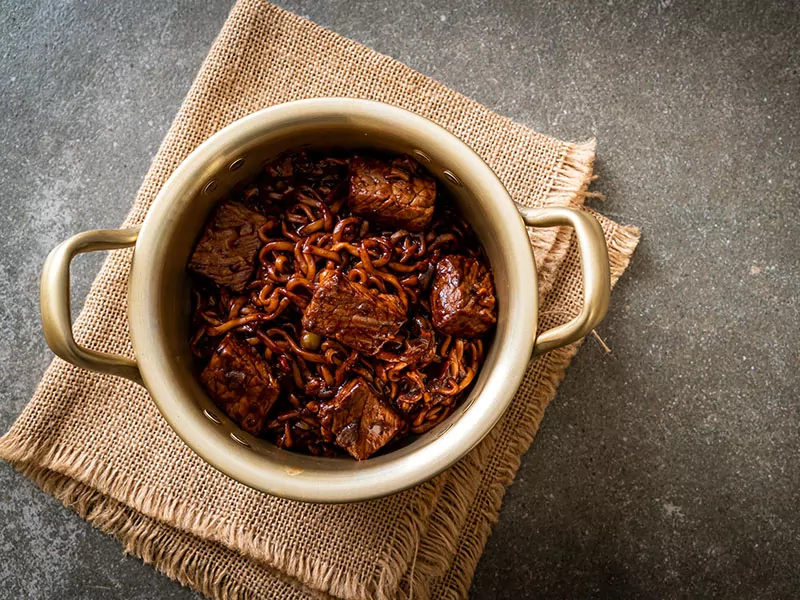
Chapaguri is the combination of 2 other varieties of Korean instant noodles, namely Jjpaghetti and Neoguri. Jjpaghetti is instant Jjajangmyeon, while Neoguri features instant spicy Jjamppong noodles. Chapaguri noodles have a spicy and umami taste.
20. Shin Ramyun
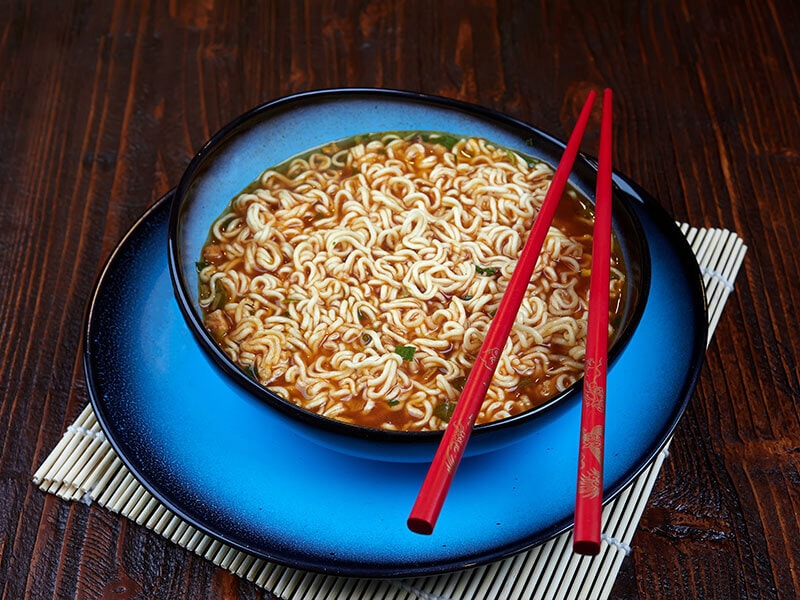
Shin Ramyun is a beef-flavored type of instant noodle. The broth is rich and deep, and the noodles are chewy. This noodle is so delicious that it has become the most popular type of instant noodle in Korea.
21. Buldak Bokkeummyeon
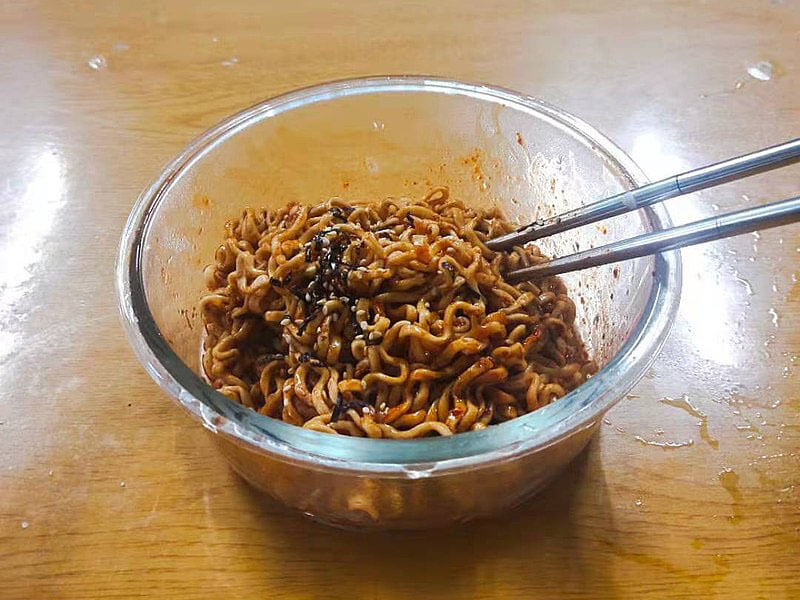
The spicy taste of Buldak Bokkeummyeon will fascinate you.
If you are in love with spicy food, I highly recommend you try Buldak Bokkeummyeon. This noodle has a chicken flavor and is super spicy. It is not a noodle soup but a stir-fried noodle dish. The noodles are incredibly chewy.
4 Best Korean Noodle Recipes To Make At Home
I would like to give you some more Korean noodle recipes to try at home. Make them and impress others! I guarantee they will ask for more.
1. Jjajangmyeon
Jjajangmyeon is one of the easiest Korean noodle recipes to make. It has a distinctive savory taste that is hard to resist. Regarding the protein sauces, you can choose to add pork belly, shrimps, or both to make the noodles more fulfilling.
2. Bibim Guksu
Fans of spicy food should never miss this Bibim Guksu recipe. Its intense spiciness is over-the-world-good. The authentic version uses Somyeon. But if it is not available in your region, you can use Japanese soba noodles. Both work incredibly well.
3. Japchae
Need a side dish for your Korean party? Japchae is the answer. This salty and tangy stir-fried noodle dish will make you addicted every time you try it. Amazingly, it goes well with every Korean main dish.
4. Janchi Guksu
The recipe for Janchi Guksu varies a lot. But all versions have a classic light, clear broth, and delicious taste. As for the toppings, you can add anything you like, from boiled eggs to mushrooms and ground beef.
Cook Janchi Guksu for your dinner today using this simple recipe!
Surprise Your Taste Buds With Korean Noodles
Korean noodles are so diverse, aren’t they? Some of them have interesting origins, while some carry the value of Korean culture. I highly recommend trying them if you have a chance. These noodle dishes will not let you down!
If you think that this article is interesting and informative, don’t hesitate to give it a like and share so that more people can know about these tasty Korean noodle dishes. In case you have questions, kindly leave them in the comment section. I will reply to you as soon as I can.
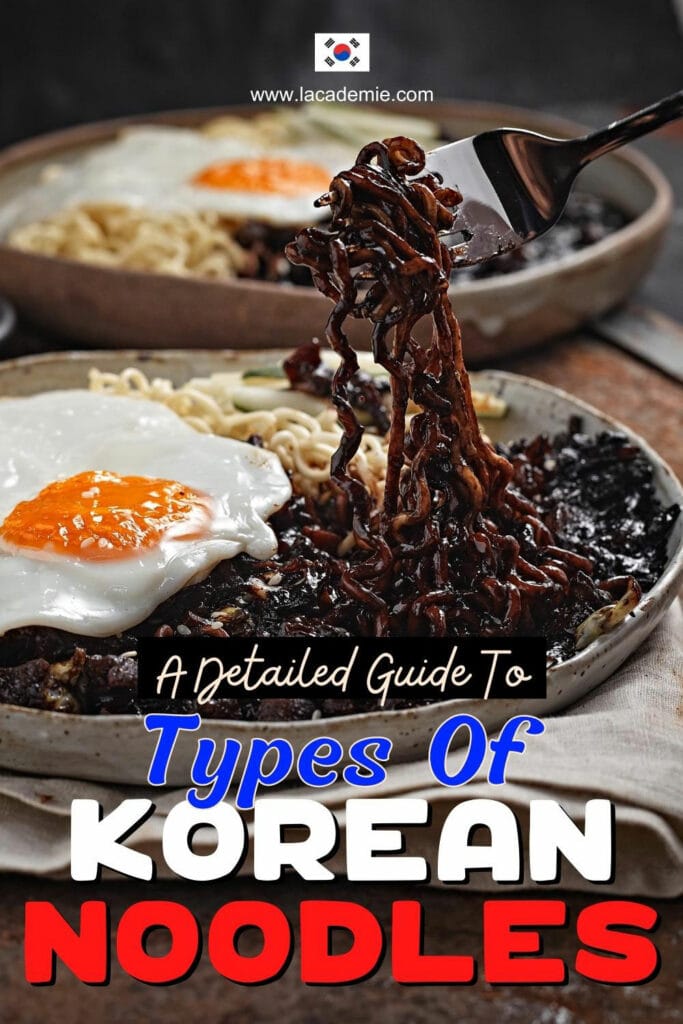


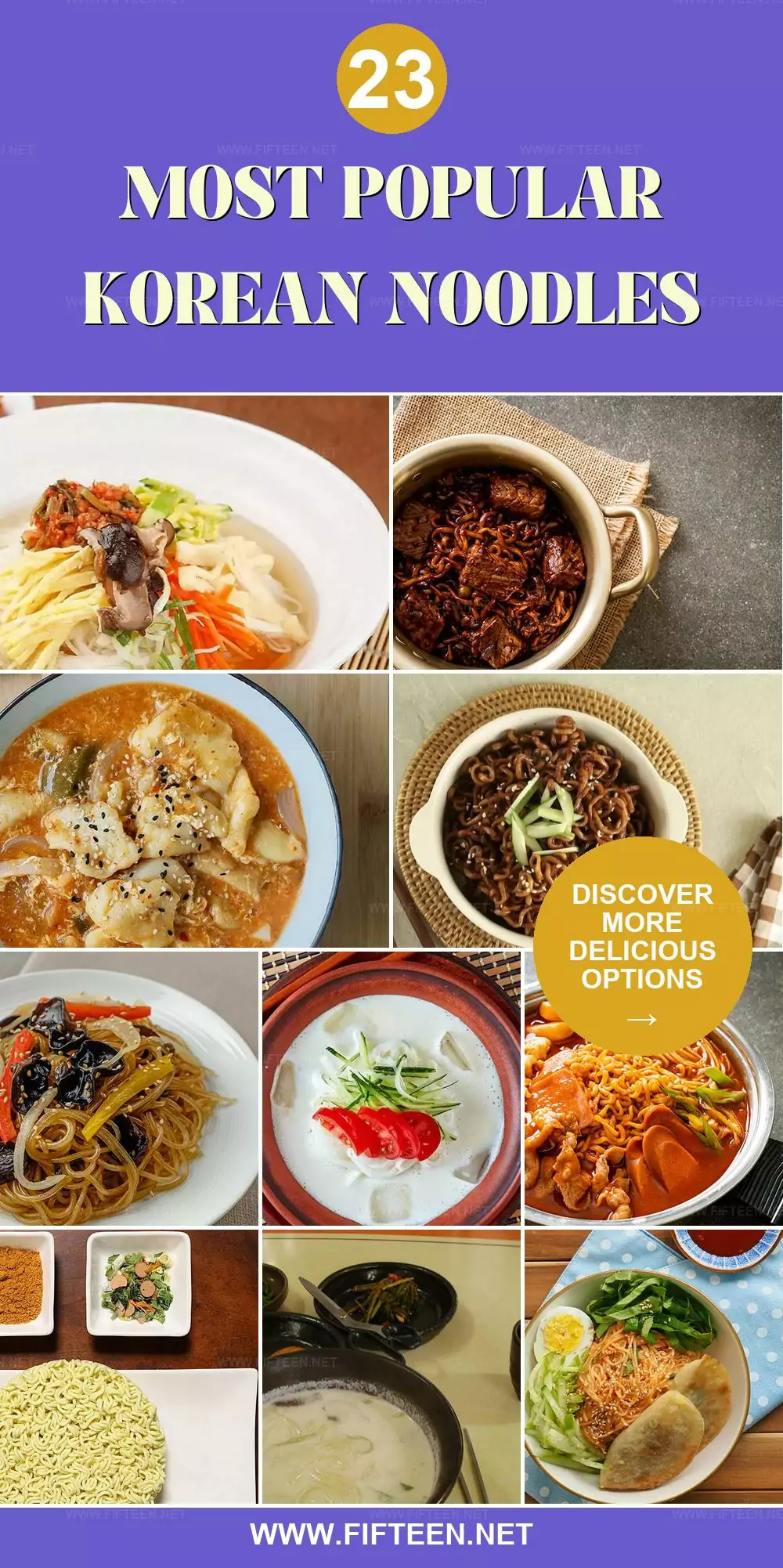
Jamie Scott
Editor in Chief, Senior Content Writer
Expertise
Home Cooking, Meal Planning, Recipe Development, Baking and Pastry, Food Editor, Cooking-video Maker, Western Food Evaluation Expert
Education
Le Cordon Bleu College of Culinary Arts
Local Community College, New York, NY
Jamie Scott is a skilled culinary expert and content creator specializing in Western cuisine. With over 15 years in the culinary field and formal training from Le Cordon Bleu, Paris, Jamie deeply understands how to blend nutrition with delicious flavors. His passion for cooking matches his commitment to making healthy eating accessible and enjoyable.
On Fifteen.net, Jamie brings a fresh perspective to classic dishes and beverages, offering readers insightful recipes, cooking tips, and a fresh view on meal planning that emphasizes taste, health, and simplicity.